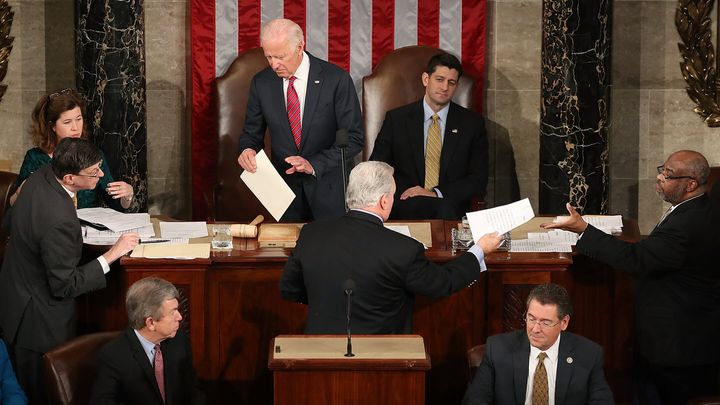Copyright, Truthout.org. Reprinted with permission. Click here to support Truthout.
Last week, presidential candidate Sen. Bernie Sanders touted his support for abolishing the Electoral College, telling a town hall hosted by the League of United Latin American Citizens that, “It is hard to defend a system in which we have a president who lost the popular vote by 3 million votes.”
His call comes as recent polling data shows most Americans support replacing the Electoral College with a national popular vote system. According to a survey published last July by the Public Religion Research Institute, Americans would prefer that presidential elections were decided by the national popular vote as opposed to the Electoral College by “roughly a two-to-one margin.”
Now, a growing movement is gaining momentum among state legislatures to make this a reality by adopting a measure that would award Electoral College votes to the winner of the national popular vote.
Oregon recently became the 15th state to join the National Popular Vote interstate compact, and the fourth state to join the compact this year after Democratic governors in Colorado, Delaware and New Mexico also signed versions of the model bill.
The model legislation in each state only becomes effective once enacted by enough states to possess the 270 electoral votes necessary for a majority. Once enacted, at least 270 presidential electors will give their vote to the candidate who received the most popular votes in all 50 states and D.C. — making that candidate president. Currently, the compact’s 15 states and the District of Columbia account for 196 electoral votes.
But even as the campaign moves closer to its goal, it still faces a long road ahead. Legislators in Maine killed a national popular vote measure in a 68-79 vote last month in the state House, with 20 Democrats joining Republicans in voting down the measure after it initially passed the upper chamber in May.
Maine is the second state to reject a national popular vote measure in recent weeks, after Democratic Nevada Gov. Steve Sisolak vetoed a version of the bill that passed his Democratically controlled legislature earlier last month.
This reticence from blue states doesn’t exactly bode well for the compact, since it will need states that voted for President Trump in 2016 to sign on in order to ultimately take effect. Still, as the 2020 presidential campaign season begins in earnest, Democratic candidates like Sanders are breathing new life into the fight for recognition of the popular vote.
After presidential candidate Sen. Elizabeth Warren was the first to call forthe abolition of the Electoral College in March during a CNN town hall, presidential candidates including Sanders; Sen. Kirsten Gillibrand; former Rep. Beto O’Rourke; South Bend, Indiana, Mayor Pete Buttigieg; Washington Gov. Jay Inslee; Sen. Cory Booker; former Housing and Urban Development Secretary Julián Castro; Sen. Michael Bennet; Rep. Seth Moulton; and author Marianne Williamson all lined up to register their opposition to the Electoral College on the record.
The issue shouldn’t be a partisan one, says John Koza, who is chairman of National Popular Vote Inc., the nonprofit behind the model bill. While Trump’s election fueled Democratic support for the compact, Koza says it has also slowed the effort among much-needed Republican-led states, where, under Obama, the campaign initially did well.
“We have never seen a good argument as to why either party has a systemic advantage under the current system or under a national popular vote,” Koza tells Truthout. “In terms of built-in advantages, the arguments just don’t hold up.”
Koza began work on the compact in 2006, largely, he says, in reaction to the 2004 election, in which the presidential race came down to just one state: Ohio. He believes the compact’s state-by-state approach is ideal for actually enacting a popular vote, since a previous effort to pass a constitutional amendment to abolish the Electoral College ultimately failed in 1969 despite passing by a large majority in the House.
“There’s nothing incompatible about just adding up all the votes in all 50 states, which is exactly what the 1969 constitutional amendment would have done, and it’s exactly what National Popular Vote does. We don’t touch this issue of state control of elections,” Koza says. “One of the advantages of state action, an interstate compact, is that if there’s any adjustment that needs to be made, … it’s a lot easier to do if you’re dealing with ordinary legislation rather than constitutional amendments.”
Basically you’re going to see a six-state presidential campaign in ’20, and that means basically the voters in 40-some states are just not politically relevant.
John Koza, chairman of National Popular Vote Inc.
However, Nicholas Miller, an emeritus professor of political science at the University of Maryland who has researched the issue says the compact raises several problems, including the fact that the national popular vote winner is an unofficial designation made in large part by the media, since no official body designates the winner of the national popular vote. The compact presumes that election officials in each member state would make the same determination of the national popular vote winner, but such state-level designations are often contested in very close elections — the kind in which the compact would make the ultimate difference.
Further, the idea of the popular vote is complicated when considering that different states have different ballot access and voter qualification laws. “Even when the media adds up the state votes to come up with the national popular vote, they’re adding up, I wouldn’t say apples and oranges but different types of apples,” Miller says, noting that some states have third-party candidates on the ballot while other states do not.
Further, legal and constitutional uncertainties remain, Miller says. If a state were to try and defect from the compact in the face of a very close national popular vote, it could produce legal controversies that would make those that followed the 2000 election seem mild in comparison.
“One could imagine all sort of legal disputes arising out of the national popular vote plan because of its somewhat ad hoc characteristics,” Miller says. “A state that was part of the plan might discover that the electorate in that state had voted very clearly for Candidate A, who was also the Electoral College winner, but Candidate B was the popular vote winner, and they might try, in a situation like that, to back out.” In other words, if a state realizes its chosen candidate won’t win if it stays in the compact, it may pull out of the compact in an attempt to help that candidate win the presidency.
Koza, however, says states can’t back out of the compact during a pivotal election year because they would have no way to appoint electors after Election Day. Plus, the compact specifies that if a state wants to leave the compact between July 20 and January 20 of a presidential election year, their departure won’t become effective until after the president is inaugurated.
Ultimately, Miller agrees that the president should be elected by the popular vote, but he advocates a national system for presidential elections in which a national agency would determine voter qualifications and ballot access rules for all 50 states. This could be accomplished by constitutional amendment, he says, although he acknowledges that such an amendment is unlikely to pass in the current political climate.
Miller’s research has found that the Electoral College is not currently biased toward one party over another. He determined that, while the Electoral College had a distinct tilt in favor of Republicans from the post-Civil War period through about 1960, since the civil rights era, the Electoral College has had no distinct tilt one way or the other.
Rather, his research confirms that the Electoral College system really advantages swing states most of all, rather than small states over large states or one party over another. “It’s probably a more significant drawback to the existing Electoral College than the problem that came up in 2000 or 2016,” Miller says.
Koza concurs. “In every single presidential election, the entire campaign comes down to a handful of battleground states,” he says. “The same thing will be worse in ‘20, because there are probably only going to be six really contested states…. Basically you’re going to see a six-state presidential campaign in ‘20, and that means basically the voters in 40-some states are just not politically relevant.”
It’s the same reason why the League of Women Voters has created its National Popular Vote Taskforce to gauge local chapters’ and state-level interest in the model popular vote bill after its national convention. Some of the League’s local branches are working with state legislators to advance the model popular vote bill, and interest in the issue is steadily growing, says Toni Zimmer, who chairs the League’s taskforce.
For the League, she says, the current system just doesn’t “satisfy the principles of one vote for one person,” and that swing states hold too much sway over the election process.
“Some states who vote a certain way each time, those states are being overlooked by the candidates,” Zimmer says. “Candidates are focusing on a handful of states, the battleground states, and there’s other benefits connected with that that aren’t going to states that aren’t being paid attention to.”
She has a point. When it comes to policy, voters in battleground states often see their issues prioritized by candidates once in office, since those candidates will need the support of voters in swing states to win re-election.
Zimmer also believes the compact’s state-by-state approach is best, since the Constitution allocates election processes to the states anyway and since, she says, trying to get a constitutional amendment passed would be impractical.
The League’s exploratory committee into the compact is part of its Campaign for Making Democracy Work, which focuses on voter representation issues including redistricting, expansion of voter access, money in politics and fighting voter suppression tactics.
“We honestly believe that everyone should have a voice, and in an election for president and vice president especially, everyone’s vote should be equal,” says Zimmer.
This same core principle is what animates National Popular Vote’s Koza. “The big picture is still that the candidate with the most votes should win, and that the campaigns should be in all 50 states,” he says.
Related:



